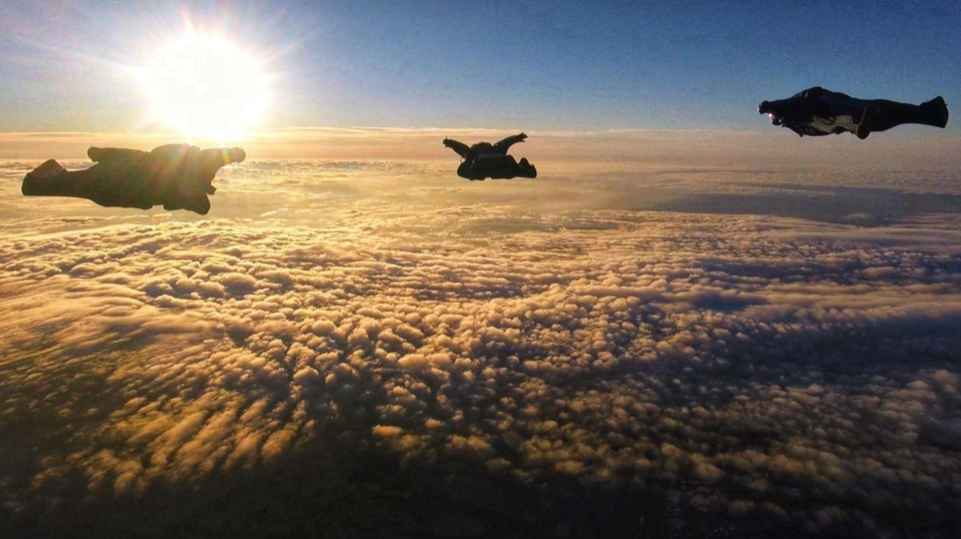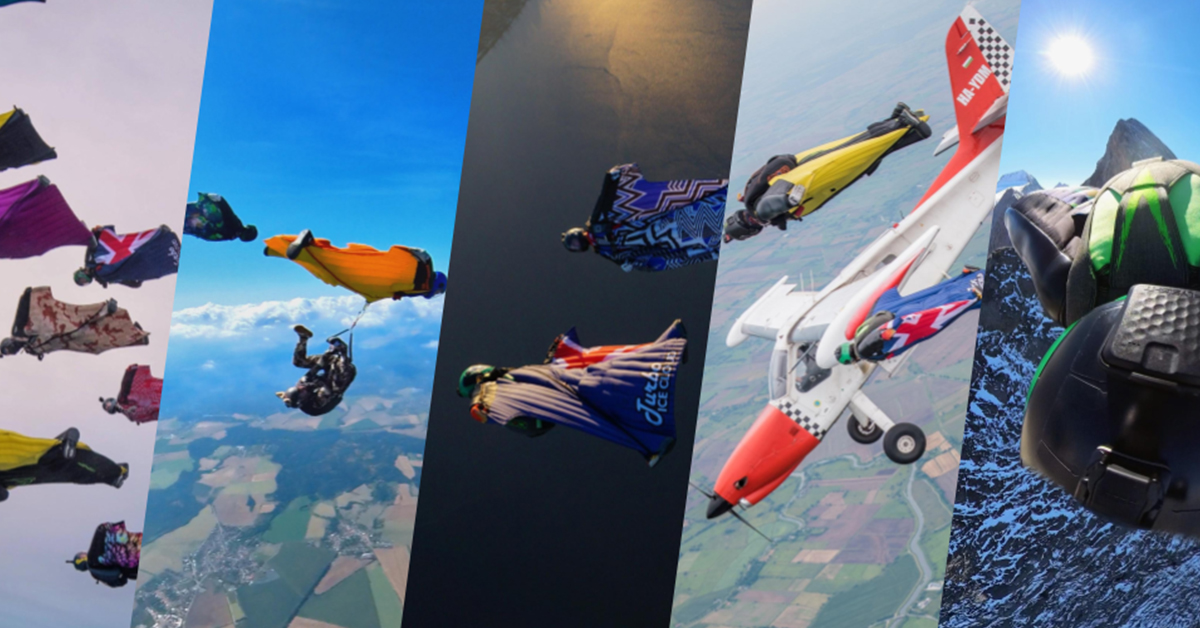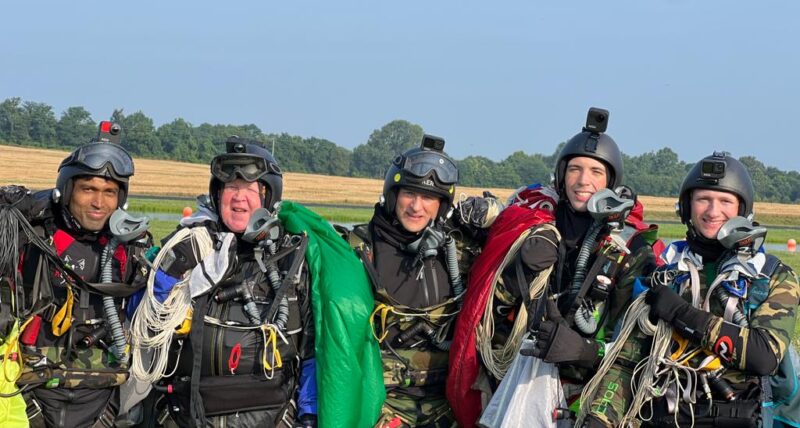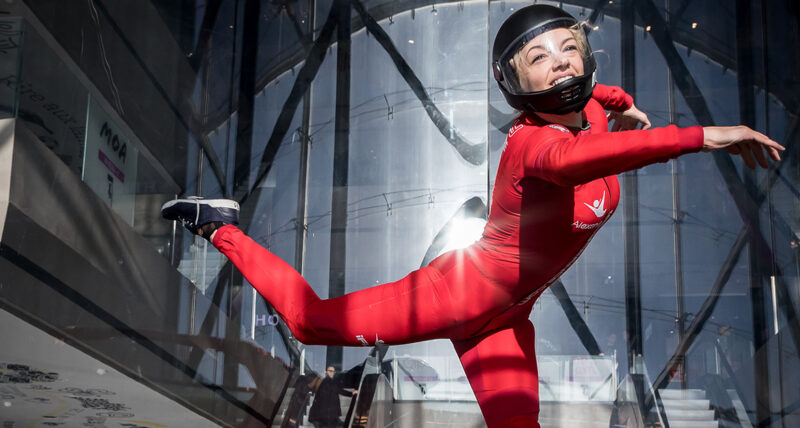A vision for your wingsuiting future
Images courtesy Jack Peploe and UK Wingsuiting
If you’ve ever waddled out to an aircraft in a fluttering nylon ball gown, you know: wingsuiting is more than just a skydiving discipline. It’s an art form, a lifestyle and a platform for the constant pursuit of improvement. It’s as thrilling as it is challenging, and it sits at the pointiest end of what’s possible for a human to do.
Jack Peploe is one of the UK’s major proponents of the discipline. He’s a three-time UK Acro gold medalist –sponsored by Squirrel, LB Altimeters, CYPRES, and Travel Parachute Systems – and serves as British Skydiving Wingsuit Technical Excellence Adviser (TEA), as well as holding a seat as an FAI and ISC Wingsuit Committee member. He has logged 450 wingsuit jumps since he started in July 2021, and along the way has become a driving force in shaping the future of wingsuiting – and he very much wants to encourage you to have a go. We spoke to Jack about the what, why and how of the future of the discipline as he envisions it, and the result is as exciting as it is doable.
Foundations
But before we join Jack to map the path into the distance, let’s start at the trailhead. Any aspirant to wingsuiting glory should, for best results, start right here.
- Hold your horses. Starting wingsuiting at 200 jumps is possible, sure – but rushing into it headlong isn’t always wise. Jack learned this firsthand. Initially eager to dive straight into wingsuiting, he later realised the importance of gradual progression – that is to say, mastering other skydiving disciplines first. Jack credits belly flying, tracking, free-flying, and head-down techniques as all contributing to his body awareness and precision – skills that are invaluable when transitioning into wingsuiting.Jack’s advice? Take your time. Enjoy the journey through different disciplines before donning a wingsuit. This approach not only builds confidence but also lays the foundation for better flying.
- It takes a village—or, at least a mentor. So reach out for help. One of the biggest challenges in wingsuiting is finding reliable information. While resources like SQRL, WS Point, Next Level and (definitely!) UK Wingsuiting provide plenty of good beta, all that data can be overwhelming for beginners. For Jack, it was finding a coach that proved to be the pivotal missing piece – a mentor who inspired him to push boundaries and excel in the discipline.“Where possible, try to find a mentor who can guide you; advise you; coach you; inspire you,” Jack insists. “It makes a significant difference, and I believe it’s extremely important.”A good coach can make all the difference. Whether you’re preparing for your first flight course (FFC) or aiming to master advanced techniques like acro flying, mentorship provides clarity and direction.
- Take it to the tube. As the vertical tunnel has done in other freefall disciplines, the wingsuit tunnel has revolutionised training by eliminating the elements of navigation and deployment, enabling pure focus on the development of flying technique. Structured, one-on-one coaching in tunnels allows flyers to refine skills like transitions, backflying, acro manoeuvres and precision docking. The tunnel’s magic is its adaptability: the driver can adjust the speed and the coach selection spans the entire range of wingsuiting subdisciplines, so a student can pivot their training to any suit or style they fancy.“The tunnel was a key part to my own development [as a wingsuit athlete],” Jack says. “You’ve got some incredibly skilled flyers [in Sweden] that really know how to teach. The skill level is consistently really high level.”If you’re hesitant about tunnel training, don’t be. Head over to Stockholm and give it a shot! The investment pays massive dividends in skill development and confidence.
The current system: what works (and what could change)
From there, the road gets steeper – and way, way more interesting. And here’s where Jack’s ideas start to take flight.
Wingsuiting progression in the UK currently revolves around structured courses: currently, the first flights in WS1, and intermediate progression in WS2.
Confused about the need for a TR1 sticker? Let’s clear that up. To do a wingsuit FFC in the UK system, you do need to have flown a tracking suit at least once, and have earned your TR1.
These syllabi focus on inarguably essential skills, such as controlled exits, precision landings, navigation (“like tracking, on steroids,” Jack grins), and recovery from unstable situations. However: while these foundational courses provide a solid foundation, Jack sees room for improvement – particularly in introducing advanced levels that cater to dynamic flying and acrobatics.
“Personally, I feel like there’s a lot missing,” Jack notes.
Jack’s vision? A much higher definition to wingsuit progression in the wide grey area past WS2. He imagines a progression, scaffolded on a community-driven framework, that balances safety benchmarks with flexibility. Jack envisions this system allowing flyers to progress at their own pace, while empowering them to push out their skills and explore interests such as flocking events and acrobatic flying.
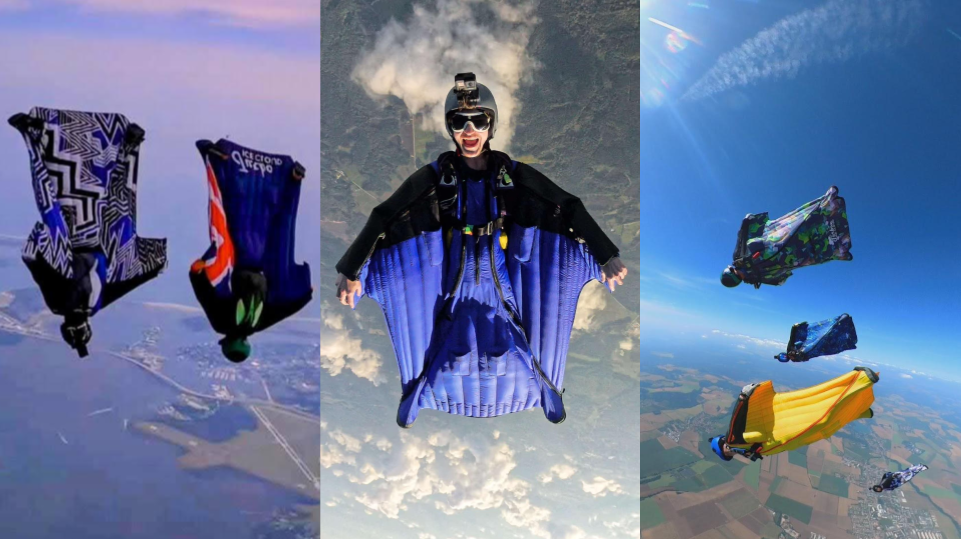
Towards a new progression framework
“Imagine a wingsuiting curriculum that goes beyond WS2,” invites Jack, “a system designed not just for skill-building but for fostering community, and joy, and retention.” To get there, he proposes the adoption of four new progressive levels to add to the existing two.
L3 Aerodynamic Proficiency: Focused on intermediate exits, performance flying techniques, docking skills, and small group leadership.
L4 Precision Acrobatics: Covering transitions, backfly exits, barrel rolls, flaring techniques, and advanced group leadership.
L5 Master Dynamics: High-speed maneuvers like flares and eagles with dynamic group formations.
L6 Advanced Vertical Dynamics: Mastery of head-down flying integrated with mixed-discipline groups.
This framework emphasises guided liberty – allowing flyers to choose their pace, while adhering to safety guidelines.
To get there, the wingsuiting community will need to collaboratively frame out the syllabus for each level – and also commit to mentoring the new generation of flyers, as the progression can only be as strong as the people who teach, and foster, it.
Squaring up to the future
Retention remains a major area of concern for skydiving in general—especially, perhaps, for disciplines, like wingsuiting, with particularly “perishable skills.” Many would-be wingsuiters drop out early – perhaps, with an intention to return – due to fear, or lack of clear progression pathways, then never put a wingsuit on again. According to Jack, addressing retention challenges requires not just better foundational coaching, but also the intentional fostering of flyer confidence through incremental skill-building.
Regardless of the challenges, Jack envisions a bright future. What if a few structural changes to how the discipline is taught make wingsuiting noticeably more accessible and attractive? What if it’s not more and better gnar footage, but deeper mentoring and community-driven initiatives that prove the key to retention, not just in wingsuiting but in the sport at large? Jack’s mission is simple: to bring joy and progression to every level of flyer while maintaining safety-first principles, with the result of “shaping the skies” for generations to come.
Whether you’re just starting out or dreaming of dynamic formations at 20k feet – wingsuiting offers endless possibilities for exploration and growth.
So only one big question remains: are you in?
